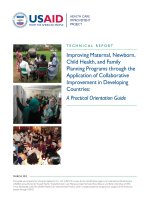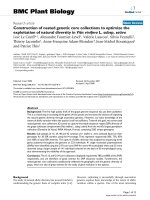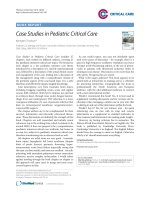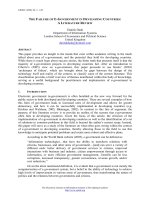The exploitation of case studies in developing critical reading skills
Bạn đang xem bản rút gọn của tài liệu. Xem và tải ngay bản đầy đủ của tài liệu tại đây (106.44 KB, 7 trang )
<span class='text_page_counter'>(1)</span><div class='page_container' data-page=1>
VNU Journal of Science: Education Research, Vol. 31, No. 2 (2015) 15-26
15
The Exploitation of Case Studies
in Developing Critical Reading Skills
Vũ Hải Hà
*<i>VNU University of Languages and International Studies, </i>
<i>Phạm Văn Đồng Road, Cầu Giấy, Hanoi, Vietnam </i>
Received 02 February 2015
Revised 26 February 2015; Accepted 22 June 2015
<b>Abstract:</b>Despite the significance of critical reading in the new information age in general and English
language teaching in particular, the demonstration of critical reading skills among the English language
teacher trainees at the University of Languages and International Studies leaves much to be desired. As
among the first attempts to enhance these vital skills, this article hypothesizes that the use of case
studies would be beneficial for the development of critical reading skills in the Faculty of English
Language Teacher Education. Adopting the action research design, the article reports the ratings and
feedback of 80 participants on these early initiatives. The findings suggest that case studies could foster
critical awareness, critical reading skills as well as the authenticity of classroom texts and tasks.
However, test washback, a lack of recency and coherence across the curriculum stood out as the major
obstacles to improving the efficiency of this activity.
<i>Keywords:</i> Critical reading, case studies, reading skills, authenticity.
<b>1. Introduction*</b>
The increasing availability of information
together with the easy access to information
sources today have been both a blessing and a
curse to the new generation, as put by American
Ex-President Bill Clinton [cited in [1]] that
“The thing I worry most is that people will have
all the information in the world, but they won’t
have any way of evaluating whether it is true or
false, A or B, even if it’s true, how to put it in a
proper perspective”. While separating the wheat
from the chaff in reading requires appropriate
critical reading skills, certain small-scale
_______
*
Tel.: 84-983536788
Email:
</div>
<span class='text_page_counter'>(2)</span><div class='page_container' data-page=2>
<i>V.H. Hà / VNU Journal of Science: Education Research, Vol. 31, No. 2 (2015) 15-26</i>
16
In this context, this article hypothesizes that
the use of case studies in teaching English
language reading skills in the current
curriculum might have positive impacts on their
critical reading skills. Beginning with a brief
review of the literature and the research
methods, the article provides the feedback of
the students on this type of activity before
putting forward certain suggestions for its
improved efficiency in the future. It is
noteworthy that although the participants in this
study are limited to a group of FELTE students,
critical reading and case study as classroom
activities are not limited to a particular
educational context. Therefore, the employment
of case studies in developing critical reading
skills could provide useful implications for not
only the teacher trainees at FELTE, but also
other university students who often rely on the
immense and diverse sources of information
today for their study and research purposes.
<b>2. A brief literature review </b>
<i>2.1. Critical reading </i>
Reading is traditionally perceived as a
one-way process. That is, the author communicates
his or her ideas to the readers through a text in a
“banking” manner [5]. In this sense, successful
reading occurs when the message intended by
the author is deposited or duplicated in the
reader’s mind. More recently, reading has been
perceived as the mediating process of social and
cultural factors [6], in which readers and writers
are interacting as members of communities in a
specific social context. As the author is
communicating his ideas through the text, the
text is not neutral but more or less represents
the writer’s sets of beliefs and attitudes, which
are significantly shaped by different political,
economic and social ideologies and
communities. Besides, writers always have a
targeted group of readers in mind, which means
some people would become their expected
audience, while a whole lot of others are
excluded. Instead of being participants, they
become “overhearers” [6] with certain
disadvantages in accessing, reading,
comprehending and reflecting on the text.
However, readers are not “blank pages” or
“empty vessels” for authors to fill in with their
texts. The Schemata Theory in reading
comprehension elaborates that readers always
match up incoming data from the text with
existing mental representations of situations,
events or phenomena [6]. In other words,
readers can bring their previous experiences,
cultures, beliefs and ideologies to their reading
of a current text. This will make reading not
simply “importing” the meaning of the text
slavishly into a blank document. Instead, it is to
examine, to contest and to struggle over the
meaning presented and represented by the text
to finally decide what to accept, to reject or to
appropriate. By doing so, the readers could be
said to read a text critically.
To provide a specific guideline for this
critical reading process, Spache [1964, cited in
[7]] conceives of critical reading as a sum of
skills that altogether demonstrate
comprehension and analysis at a high level.
These reading skills include analyzing the data
source, understanding the writer’s purposes,
distinguishing facts from opinions, reasoning,
forming judgments, and detecting propaganda
devices. Kirszner, L.G. & Mandell, S.R. (2000,
p. 485) listed 15 questions that a critical reader
needs to answer in reading any text:
</div>
<span class='text_page_counter'>(3)</span><div class='page_container' data-page=3>
<i>V.H. Hà / VNU Journal of Science: Education Research, Vol. 31, No. 2 (2015) 15-26 </i> 17
- What do you think the writer is suggesting
or implying? What makes you think so?
- What is the writer’s purpose?
- What audience is the writer addressing?
- Is the writer responding to another
writer’s ideas?
- What is the writer’s main point?
- How does the writer support his or
her points?
- Does the writer use facts, opinions or a
combination of the two?
- Does the writer include enough supporting
details and examples?
- What pattern of development does the
writer use to arrange is or her ideas? Is this
pattern the best choice?
- Does the writer seem well informed?
Reasonable? Fair?
- Do you understand the writer’s vocabulary?
- Do you understand the writer’s ideas?
- Do you agree with the points the writer
is making?
- How are the ideas presented in this section
like/unlike those presented in other sections
you’ve read?
This article draws on these questions to
characterize and evaluate critical reading skills
in subsequent discussions.
<i>2.2. Case-study as a classroom activity </i>
Pioneered at the Harvard Business School,
case studies as a classroom activity has
attracted attention from a number of scholars
and writers such as Christensen and Hansen [8],
Boehrer and Linsky [9] to name just a few. Two
key features are commonly underlined by these
authors to define a case study: first, it
constitutes real or realistic events; second, it
offers issues or conflicts to be resolved. A good
case study, as characterized by Boehrer and
Linsky [9] “presents an interest-provoking issue
and promotes empathy with the central
characters” (p.45). For this to happen, a case
does not only involve an issue but also
facilitates the learners through its
multi-layeredness. Each time a layer is taken off,
another appears until the learners reach to the
“core”, figuratively the core of the issue.
It is noteworthy that case studies are neither
of the same level of complicatedness nor
always approached in the same way. Among
various types of cases, some of which could be
as long as hundreds of pages and require the
whole semester to dissect into, this study only
focuses on one of them: the mini case study.
This is often a short story, presented in one or
two paragraphs and thus succinct in its content.
It can be used by instructors to lead in the
lesson, help learners translate theories into
practice or serve as a follow-up activity. The
“green” house below is an example of a
mini-case for a class on marketing [10]. Despite its
brevity, this story is a case study by definition:
first, it is based on a realistic situation consisting
of an authentic setting and specific facts and
figures; second, it offers a problem related to the
area of marketing (i.e., promoting and advertising
a new type of house on the market).
<b>The “green” house </b>
</div>
<span class='text_page_counter'>(4)</span><div class='page_container' data-page=4>
<i>V.H. Hà / VNU Journal of Science: Education Research, Vol. 31, No. 2 (2015) 15-26</i>
18
Scientists have shown that conventional
houses play a major part in global warming,
depleting the ozone layer and destroying
tropical rain forests. Consequently, the
builders believed that a new type of consumer
was emerging: one who is prepared to make
choices based on what is best for the planet,
but who demands that the product does not
cost too much.
The “green” house emits only three tons of
carbon dioxide a year, just half that of a
traditional house. There is also twice the
regulatory amount of loft insulation and the
walls and floors are three times better insulated
than a standard new home. The cavity walls
have 15 cm (rather than the standard 5 cm)
filled with rock wool. The loft has 30 cm of
non-irritant brown cellulose, made from
recycled newsprint. Under the floor there is a
10 cm layer of CFC-free polystyrene. The
house also features a high-efficiency gas
condensing boiler which extracts more of the
heat from the flue gases and uses 15 per cent
less gas for the amount of heat generated than
the standard boiler, so only half the heating
energy should be used. The home is built on a
south-facing slope and most of its windows are
on the south side to take maximum advantage
of the sun. They are all double-glazed with
Pilkington “K” glass which has an extra copper
film to reflect heat back into the room reducing
heat loss by 40-50 per cent.
The efficiency of the house is reflected in
the award by the National Home Energy
Foundation, which awarded the house almost its
maximum rating (9.3 out of 10).
The price of the home is £105000, which is
£5000 more expensive than if it did not have all
of these extras. But the builders believe that
buyers will make big savings on heating and
lighting besides playing their part in making the
world a healthier place.
<i>Questions </i>
1. Who is the type of buyer likely to be
interested in buying a ‘green’ house?
2. Develop an advertising platform to
appeal to them.
3. Bearing in mind that funds restrict the
advertisement to a maximum of 8 cm 10 cm
wide, design an advertisement for the house.
Note that space precludes the use of a
photograph.
Due to such flexibility, authenticity and
empowerment to the learners in solving the
issues, case studies are expected to provide a
powerful impetus for the learners in developing
their critical reading skills. However, in what
way and how far case studies could promote
critical reading skills are the two questions this
article turns to in the following discussions.
<b>3. Research methods and procedure </b>
<i>3.1. Research design and methods </i>
The study employs the action research
<b>model of seven steps proposed by Nunan [11]: </b>
- Steps 1 & 2: Initiation Step and
Preliminary Investigation: Baseline data is
collected via questionnaires and interviews with
the participants to study their perceptions and
problems with critical reading.
</div>
<span class='text_page_counter'>(5)</span><div class='page_container' data-page=5>
<i>V.H. Hà / VNU Journal of Science: Education Research, Vol. 31, No. 2 (2015) 15-26 </i> 19
Teacher roles
Goals
Student roles
Input
TASK
Activities Settings
- Step 4: Intervention: Case studies are
designed basing on the baseline data to help
students address specific problems and develop
their critical reading skills. Then the teachers
are trained to aptly apply case studies over two
semesters with the researcher.
- Step 5: Evaluation: A questionnaire
will also be issued to the students to evaluate
the effects of case studies on their critical
reading skills.
- Step 6: Dissemination: The researcher
runs a workshop for colleagues to present the
study results. Through the workshops,
comments on the students’ performance and
assessments of the study results are collected
through questionnaires.
- Step 7: Follow-up: Putting all collected
data, comments and feedback together, the
researcher revise the research paper and bring
up possible techniques to enhance the effects of
case studies on critical reading skills.
The participants in the study were 80
third-year Fast-track students in FELTE. Although
Cervetti, Pardales and Damico [7] assert that
language competence is as a prerequisite to
developing critical reading skills, these
third-year Fast-track students were selected on
convenient grounds. That is, as their teacher (or
a colleague of their teachers), I could ensure
that critical reading was developed and the
action research design was employed in these
classes throughout the academic year of
2013-2014.
<i>3.2. Designing case studies </i>
As indicated in the research design above,
writing good cases plays a pivotal role in the
success of the critical reading program. As they
were employed as classroom tasks in the
language course, these cases were examined
and designed according to different components
of a communicative classroom task (Figure 1).
<i>- Goals</i>: To identify the objective of the
case in particular and that of the course in
general, the writer referred to the guiding
questions for critical reading presented above.
Due to time constraints, the questions which
have been addressed in the previous language
courses (such as identifying the main ideas, i.e.
“What is the writer saying?”; or reading for
inferences, i.e. “What do you think the writer is
suggesting or implying?”) were not identified
as the course focuses. That would leave nine
other questions, which could be categorized
into five main groups as Table 1 indicates.
In the illustrative case in Figure 2, its
primary objective is to help students reflect on
the lexical choice and detecting biases. By
Table 1, it could be studied in Session 4 to
illustrate the session focus as well as to review
the preceding Session 3.
g
</div>
<span class='text_page_counter'>(6)</span><div class='page_container' data-page=6>
<i>V.H. Hà / VNU Journal of Science: Education Research, Vol. 31, No. 2 (2015) 15-26</i>
20
Table 1. Objectives of the critical reading program
f
Session Session focus Corresponding critical reading questions
1 Identifying the author’s
purposes and targeted audience
- What is the writer’s purpose?
- What audience is the writer addressing?
2 Reflecting on the organization
and development of ideas;
- What is the writer’s main point?
- How does the writer support his or her points?
- Does the writer include enough supporting details
and examples?
3
Reflecting on the accuracy of
information and detecting
biases
- Does the writer seem well informed?
Reasonable? Fair?
- Does the writer use facts, opinions or a
combination of the two?
4 Reflecting on lexical choice
and rhetorical devices - Do you understand the writer’s vocabulary?
5 Reflecting on the author’s
arguments
- Do you agree with the points the writer is
making?
<i>Table 1. Objectives of the critical reading program</i>
<i>- Settings</i>: Certain parameters which impact
the successful employment of case studies,
particularly time, facilities and the number of
learners should also be taken into consideration.
To begin with, the time allocated for the
critical reading program is 20 hours in total, or
04 hours in class for each session above. As this
could be too short to introduce, practice and
revise these skills properly, case studies were
introduced and reviewed by the teacher in class,
but investigated by the students at home. These
self-study activities were supervised via written
reports and oral feedback on a regular basis.
Regarding classroom facilities, the students
were encouraged to use the Internet and other
resources to get access to the texts in these
cases (see Figure 2 for an example). This aimed
to increase the authenticity of the text as well as
the reading process. Nevertheless, as most
classrooms in FELTE were not connected to the
Internet, students were instructed to work at
home and in groups to provide mutual technical
support when needs be.
Finally, as the class size was rather large
(22-25 students per class), each group was
divided into smaller groups of 3-5 students to
allow for more time and space for each
individual to voice and argue for their opinions.
<i>- Input</i>: Since there was not a particular
coursebook or referential material in Vietnam
that used case studies to teach English or
critical reading skills, all the cases were written
by the researcher from scratch. To improve the
quality of this writing, references to a wide
range of related materials as well as the
collection of feedback from the teachers and
students were conducted on a regular basis. A
case in point is the article in the Figure 2, which
is quoted from Epstein [13]. In fact, every
single case in the whole critical reading
program was piloted for two semesters and
revised remarkably to ensure an authentic
setting, specific facts and figures, and a
problem in the conclusion - three main criteria
of good cases as reviewed above.
</div>
<span class='text_page_counter'>(7)</span><div class='page_container' data-page=7>
<i>V.H. Hà / VNU Journal of Science: Education Research, Vol. 31, No. 2 (2015) 15-26 </i> 21
interactions. In Figure 2 for instance, the case
revolves around a discussion between a
Vietnamese student and a foreigner on cultural
stereotypes, a common topic in social exchanges.
As the texts were located in its authentic
and original settings, it facilitated the collection
of specific facts and figures. In the illustrative
case (Figure 2), the lead-in introduction from
Wikipedia and the link to popular jokes about
blonde girls could help to inform the readers of
relevant background information related to the
case study.
Finally, a problem is placed at the center a
case. For this to be helpful for the development
of critical reading skills, the question must be
clear, alluring and open for various
perspectives. In the illustrative case, the
question of “As a friend, what would you say to
Chris and Van?” is open-ended enough to invite
learners to to express their opinions in the
manner they prefer (i.e., agreement,
<b>disagreement, or neutrality). </b>
- Classroom activities and roles of learners
and teacher: To foster learner-centeredness, the
cases were provided before the session for the
students to study at home. Within two weeks,
they were asked to investigate the case
individually before working in groups to share
their opinions. Then they were expected to
come up with a group conclusion, even though
it could be “agree to differ”. It was through this
process of discussion that cooperative learning,
reflective practices and reasoning skills could
be enhanced for the common purpose of critical
reading skills development.
Before the session, the teacher read the
minutes or records of these discussions to
provide feedback as well as took notes of
interesting or questionable arguments and ideas.
In the lesson, the teacher brought up these
arguments and ideas for a whole-class
discussion before presenting the theoretical
grounds of these cases. This approach to
experiential learning [14-16], where students
are asked to have hands-on experience before
formal learning, was the key principle
underlying the implementation of this activity.
After a semester teaching and learning with
case studies, the students’ feedback was
collected. Table 1 summarizes the survey
responses of 80 participants on five main
criteria. As could be seen, the ultimate goal of
the program (a) was not only rated the highest
(Mean=5.7, equivalent to “Agree-Strongly
Agree”), but also had the smallest standard
deviation (0.93). It was followed closely by the
authenticity of the texts and tasks (Mean=5.6,
SD=0.96)) and thinking and verbal skills
(Mean=5.32, SD=0.95). These positive
evaluations could be elaborated further by the
qualitative data provided by these respondents:
I find the cases really varied in terms of
skills and topics … The texts are those we
could find in daily reading but used to overlook
the fallacies in them.
After studying critical reading with these
cases, I’ve started to read selectively. I realize
that I used to be really silly because I often fell
into the traps set up by these authors … or I
knew something was problematic but could not
explicate or name that problem (but now I can).
Before the sessions, I had very little idea
about rhetorical devices in English, and their
power in conveying the author’s ideas. But now
I have a clearer idea of such devices.
</div>
<!--links-->









